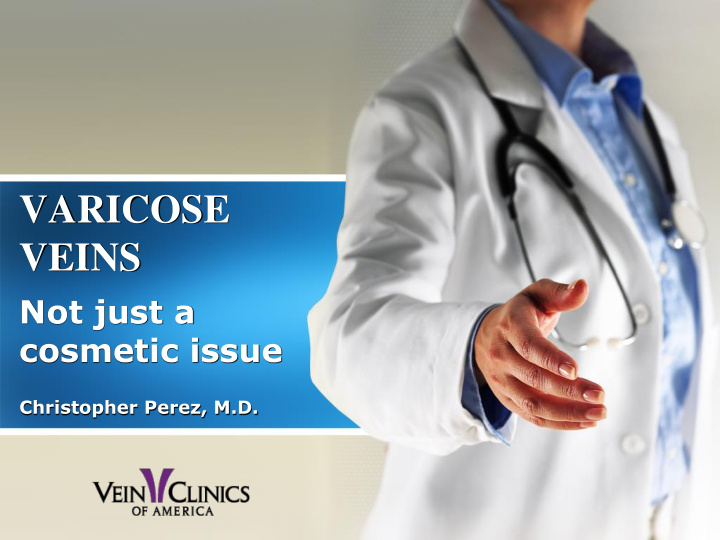



VARICOSE VEINS Not just a cosmetic issue Christopher Perez, M.D.
Objectives Introduction 1 Overview of venous system 2 What are varicose veins? 3 Risk factors and symptoms 4 Treatment approaches 5 Question and Answer 6
Introduction What is Venous Medicine and why is it important? • Specialty dedicated to the diagnosis and management of venous diseases • Doctors that specialize in vein disease • American Medical Association recognized specialty since 2005 • Board Certification since 2008. American Board of Venous and Lymphatic Medicine
Who does venous disease affect?
The cost of chronic venous disease • 2 Million working days lost per year • 3 Billion Dollars annual treatment costs • 20,000 new venous ulcer patients annually • Chronic Venous Disease accounts for 1-3% of the total health care budget
The Venous System • 25 miles of veins • Made of a complex series of valves and pumps • Moves blood “uphill” • Functions as a reservoir
Healthy Veins
What happens if the venous system fails? Illustration by Linda S. Nye
What do we know about vein disease? • Vein disease is treatable • Often genetic in origin • Chronic • If left untreated, worsens with time • Can lead to more serious health problems and complications
Risk factors and Symptoms Cause and Effect Heredity Pain Hormones Itching/Burning Gravity Varicose Fatigue Veins Time Swelling Trauma Restlessness Leg muscle Pump failure Heaviness Postphlebitic Syndrome
What factors impact varicose vein symptoms? Worsen Improve Standing still Elevating the Legs Sitting still Walking Lying still Heat (dilates veins) Compression Stockings Menstruation/Pregnancy
What do Varicose Veins Look Like?
Spider Veins ( Telangiectasias )
Reticular Veins “medium veins”
Large Varicose Veins
If left untreated…
Evaluation and Treatment of Vein Disease
Treatment Options • Conservative Management • Traditional Surgery • Minimally Invasive -Thermal -Sclerotherapy
Conservative Treatment Options • Compression stockings • NSAIDS • Exercise • Leg Elevation • Avoiding High Heels • Weight Loss
Traditional Surgery Vein Stripping Surgery – Archaic – Hospital stay required – Extended recovery period – Not comprehensive Surgical Stab Phlebectomy – Small segments of vein are removed through incisions – Removes the abnormal vein, but not the root cause of the reflux – Can not be used for spider veins
Minimally Invasive Starts with an Ultrasound Evaluation!
Minimally Invasive Surface Treatments Skin Surface Lasers – Heat energy burns through the skin – Will only work for extremely fine spider veins Surface sclerotherapy – Abnormal veins are injected with a sclerosant using a very fine needle – With appropriate strengths of a proper sclerosant (not saline), it is effective for all types of varicose veins
Thermal Energy Endovenous Laser Treatment (ELT) • In office procedure • Walking immediately afterward • Safe and Effective • Not comprehensive alone • Most effective when used in conjunction with ultrasound guided sclerotherapy
Ultrasound Guided Sclerotherapy Microfoam Sclerotherapy – Abnormal veins are injected with a sclerosant with ultrasound monitoring – Ultrasound monitoring and guidance provides safety and comprehensive treatment – Can be used alone or in conjunction with Endovenous Laser Treatment
Will Insurance Pay for Varicose Vein Treatment? YES! “Medical Necessity” needs to be determined • Persistent symptoms or complications • Duplex Ultrasound evaluation • Conservative treatment trial
Conclusion • Vein disease affects many people • Vein disease is treatable • There are several options to treat vein disease, find the one right for you • Seek treatment from a physician experienced in treating the entire spectrum of vein disorders
Questions?
Recommend
More recommend